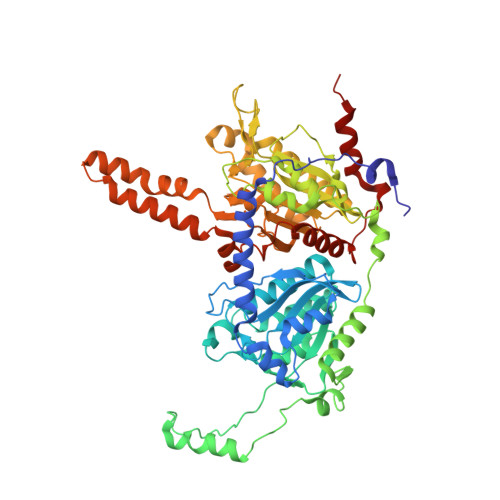Crystal structure of the carboxyltransferase subunit of the bacterial sodium ion pump glutaconyl-coenzyme A decarboxylase
Wendt, K.S., Schall, I., Huber, R., Buckel, W., Jacob, U.(2003) EMBO J 22: 3493-3502
- PubMed: 12853465
- DOI: https://doi.org/10.1093/emboj/cdg358
- Primary Citation of Related Structures:
1PIX - PubMed Abstract:
Glutaconyl-CoA decarboxylase is a biotin-dependent ion pump whereby the free energy of the glutaconyl-CoA decarboxylation to crotonyl-CoA drives the electrogenic transport of sodium ions from the cytoplasm into the periplasm. Here we present the crystal structure of the decarboxylase subunit (Gcdalpha) from Acidaminococcus fermentans and its complex with glutaconyl-CoA. The active sites of the dimeric Gcdalpha lie at the two interfaces between the mono mers, whereas the N-terminal domain provides the glutaconyl-CoA-binding site and the C-terminal domain binds the biotinyllysine moiety. The Gcdalpha catalyses the transfer of carbon dioxide from glutaconyl-CoA to a biotin carrier (Gcdgamma) that subsequently is decarboxylated by the carboxybiotin decarboxylation site within the actual Na(+) pump (Gcdbeta). The analysis of the active site lead to a novel mechanism for the biotin-dependent carboxy transfer whereby biotin acts as general acid. Furthermore, we propose a holoenzyme assembly in which the water-filled central channel of the Gcdalpha dimer lies co-axial with the ion channel (Gcdbeta). The central channel is blocked by arginines against passage of sodium ions which might enter the central channel through two side channels.
Organizational Affiliation:
Max-Planck-Institut für Biochemie, Abteilung Strukturforschung, Am Klopferspitz 18a, D-82152 Martinsried, Germany.
















